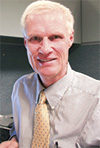I have been in New York for nearly two months. The bulk of my work includes meeting landowners and evaluating their performance at meeting water quality standards. These are called annual status reviews. One in particular is memorable. The landowner is just a few years older than me. He is the middle generation of three. His father is now home from an extended hospital stay – and being home includes a daily visit with a nurse.
The younger generation includes two brothers working on the farm and two daughters who are married and living in other states.
The landowner and I sat in his kitchen to meet one another and, largely for me, the time to listen to him describe the farm history and the family dynamics. At 65 years old, he is already spending time off the farm, and in fact just prior to this visit, he and his wife of a little more than 40 years spent some time on an ocean cruise. They enjoyed every minute of the time away, although he admits eagerness in coming back home and checking on things.
What is interesting is the news that he is meeting with the banker, and this meeting was scheduled for later in the week. I noted to myself that the visit to the banker had two purposes. One, to talk about purchasing more equipment – and two, the possibility of building a milking parlor and therefore no longer using the stanchion barn with an overhead pipeline.
He and his wife were going to the bank without the “boys.” I did not comment. This was my first meeting, and I am still a stranger for the most part. Yet I have seen this approach before. Often on every farm, and especially for those with multigenerational transfer, the strategic discussions are so important that the younger generation must be included.
I am thinking now of farms, especially with the production area site of worn-out buildings and depreciated facilities. What to do, especially for the next generation. My take on this question is not complicated.
The two generations must decide how much longer the facilities can exist in the context of efficiency and labor management. On this farm, the entire dairy facility is worn out with the exception of a waste storage facility. The 180-day concrete facility is about 10 years old and is in good shape. But the rest is not.
The visit to the banker should include the two sons because they have a vested interest in the future of this farm. The older generation must know something about their willingness to keep the dairy farm going … a perennial question that is asked thousands of times a day across the entire dairy industry.
On this farm, the equity of land is a hugely valuable asset. Yet the older generation shudders to think about going into debt for 10 or 20 years to pay for equipment, a new parlor and a feeding barn.
And then the question comes up: What size? On this farm there are 80 milk cows and another 70 or so youngstock as replacements. What does the banker tell them? One answer is related to the land base.
If short, then adding to the 80 cows becomes a real challenge in terms of growing feed and manure utilization. On this farm there are several hundred acres of largely perennial grass, so additional cows is a good option.
What about labor? I did not talk about this with the older generation. However, I did with both sons. And both of them told me there are many people here willing to work on a dairy full-time or part-time.
Another important consideration is the wives of these three men. All are married, and while I did not meet them, their thoughts must be included in the planning process. In the NRCS Conservation Planning Handbook, we planners are taught to make sure we are planning with a full (as full as possible) understanding of the landowners’ goals and objectives.
One question is: How many people do we listen to? My suggestion is certainly the generations currently involved and those in the future and their spouses should be included. Yet, on this farm, I have the sense this is not the case.
I will be back on this farm many times. There are several unresolved resource concerns we will address. As I get to know these three families better, I will have a better understanding of the farm family dynamics. I may have the opportunity to help guide them toward a greater understanding of farm family dynamics as an important component of farm planning.
As I often write and say, the family farm – the physical attributes of the farm – can be readily inventoried and evaluated. The farm family – the people on the farm and those not on the farm but part of the family – is a much harder dynamic to understand. Understanding takes time.
The meeting with the banker is now history, and so I need to go back out to this farm and listen to the outcome. I hope it is a positive one. And I will define that not in terms of whether the family farm is staying in business as is, or building new buildings on the production area site. Rather, that the goals and objectives for all of the family have been stated and acted upon.
If we do not have this outcome, there is a strong likelihood the family farm will be an unhappy place – and possibly soon out of business. This has much less to do with economics and financial management and everything to do with collectively working toward a goal and doing whatever it takes to reach it. This, of course, is the human environment that must be correct before anyone claims success. PD

Mike Gangwer
Agricultural Scientist
USDA-NRCS





